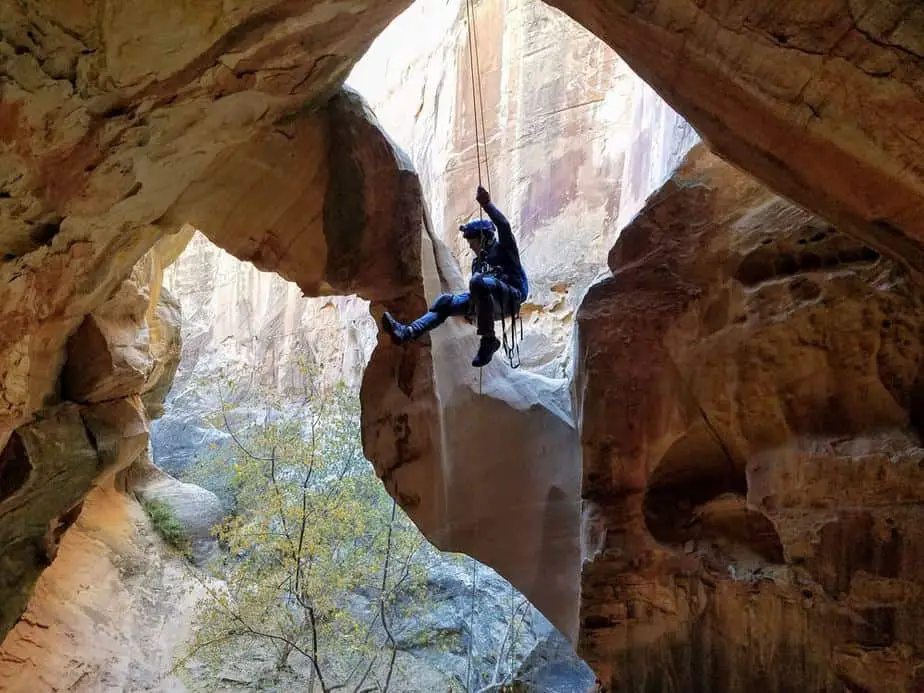The best part of technical canyoneering or canyoning is the rappels- without them, it wouldn’t be technical canyoneering. While many novice canyoneers start out with simple belay or rappel devices like an ATC or an 8-ring, these elementary options won’t meet the needs of more advanced canyoneers.
What is the Best Descender for Canyoneering? The best and most widely-used rappel devices in modern canyoneering are the CRITR2, the Hoodoo-SL, the SQWUREL, and the ATS. All have very similar functionality, are versatile enough to handle any situation, and are extremely safe when used properly.
One of the most necessary features in a solid canyoneering device is the ability to modify friction levels while rappelling. This becomes important as the angle of a rappel changes grade- especially in overhung conditions. There are several other key features required in a canyoneering rappel device, which we’ll explore further below.
Note that I use the words belay device, rappel device, and descender interchangeably in this article.
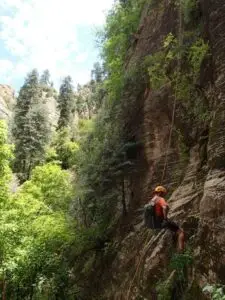
What to Look for in a Canyoneering Rappel Device
A single-use ATC or even a somewhat-versatile 8-ring is not enough for longer or more complicated rappels. Back when I was newer to canyoneering I ran into a situation where I was unable to add additional friction to an 8 ring while rappelling a 200ft (60m) drop on a very thin 8mm rope. I burned through my gloves and ended up hitting the ground pretty hard at the bottom of the rap. At that point, I vowed to get my hands on a better device. I scoured internet forums, and asked all of the canyoneers I knew what they use and what they like and dislike.
These are some of the points I considered:
Versatility: I wanted a descender that would be functional enough for every canyon I go through. The requirements I had were:
- Select a friction level during set up
- Adjust the friction level while rappelling
- Ability to stop, lock off, and go hands-free during a rappel
- “Canyon mode” quick release for rappelling into water
- Single or Double Strand
- Work with any size of canyoneering rope
- Useful as a block
Simplicity: I wanted to find a device that would be very simple to use for just about anyone, and wouldn’t require much explanation. I tend to bring lots of novices on trips, which means sharing gear and teaching the basics.
It was important to find a device that could be used by anyone somewhat familiar with rappelling. There are several devices out there that are cool and very versatile, but can be dangerously misused by a novice. I didn’t need one with 40 different slots for different situations.
Safety: Cross-loading is a very dangerous phenomena that many people are unaware of. Essentially, an 8-ring style device can get jammed while loaded so that the force is applied to the weakest parts of the carabiner.
This can cause the gate of a carabiner to fail, sending the person rappelling plummeting to the bottom. While rare, accidents and deaths have occurred. More information on cross-loading in this article I wrote: How to Rappel with a Figure 8 .
.
Because I know that it happens, I am cautious to watch for it while I am rappelling; however, it’s not something novices always watch for. Modern canyoneering devices include a plastic or rubber o-ring insert around the carabiner that keeps it from slipping around.
Durability: A wet and sandy Southern-Utah Canyon can wear through a soft belay device in a matter of a few rappels. Normally I consider wearing through gear a sense of pride, rather than an unfortunate economic hit, but not when it happens in a single canyon!
Some devices are made from softer aluminum than others. I looked for a device that is symmetrical so that I could flip it over and wear both sides evenly which would increase the lifetime of the $50 device.
Common Rappel Devices for Canyoneering
Of course, there is no single ‘best belay device’ for everyone. A lot of these are similar enough that it really just comes down to which one is in stock on the day you decide to buy. These are the most common ones that I see people using out in the wild.
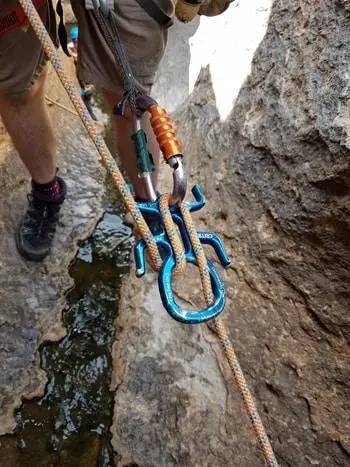
Imlay “Critr2”
This is probably the most common descender that I see among serious canyoneers. It pretty much looks like an 8 ring with arms and legs, which makes it really easy for beginners to understand. These appendages are very convenient for adding or removing friction on the fly, as well as for locking off the rap and going hands-free.
The Critr is symmetrical so that it can be flipped over, essentially doubling the lifespan of the device. It really hits everything on my list, and is a great choice. The second generation is better with ropes on the more extreme ends of the spectrum, above 10mm and below 9mm.
CanyoneeringUSA: Imlay Critr2 Rappel Device
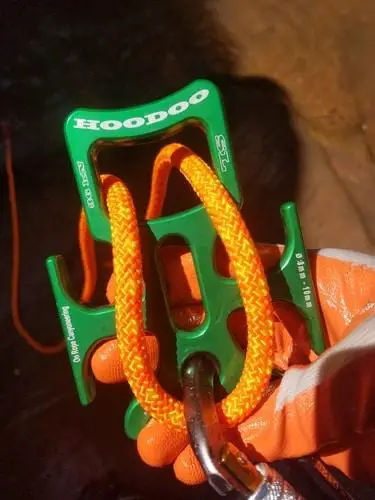
On Rope Canyoneering “Hoodoo-SL”
The Hoodoo is very similar to the Critr2, but is a bit smaller and a bit lighter. Even the price is identical. Functionality is essentially the same, though some say the Hoodoo allows for more incremental friction changes.
It is also symmetrical, and includes an o-ring to secure the carabiner. It does have a little bit more friction than the Critr because the edges are squared off.
I bought and use a Hoodoo, mostly because I live in Arizona where On Rope Canyoneering is based. I have no complaints about the device. Among the groups I usually go with, we are pretty evenly split between the Hoodoo and the Critr. I expect to see the Hoodoo show up more frequently over the next few years, since it’s a new device (2018).
Buy direct from On Rope Canyoneering

Bluu Gnome “Sqwurel”
The Sqwurel debuted right around the same time as the first generation of Critr, and has since moved on to the v2 and then (2019) the V3. When the SQWUREL3 came out I got my hands on one to test out. I had never personally tried the Sqwurel before, but it is a lot of fun.
The basic set up is similar to an 8 ring, but with a tail that functions like a rappel rack. The best thing about the Sqwurel is adding friction on the fly. It is incredibly easy to pull the rope into one of the tail slots and slow down. This is Katherine’s favorite descender for canyoneering.
This is the unique option among the new generation of rappel devices, but comes in a couple of bucks higher. The Sqwurel is a little bit longer than the Hoodoo and Critr, but narrower as well.
The first two iterations of the device had some rope twist issues, but the newest (v3) seems to have resolved the problem. The device cannot be flipped over for even wearing, but it still lasts longer than a pirana, ATS, or 8 ring.
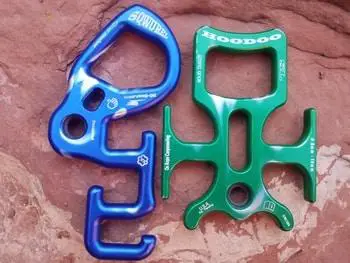
For Reference, here’s the SQWUREL next to the HOODOO
Buy direct from Bluu Gnome Gear
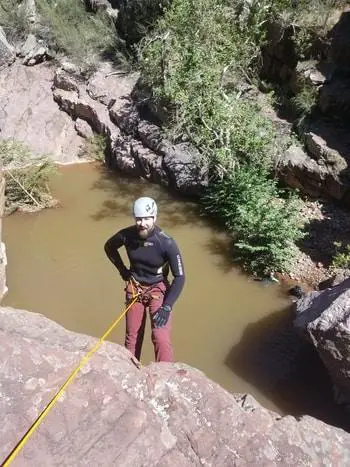
Sterling “ATS”
The ATS has been around a lot longer than either the Critr or the Hoodoo. If I had to guess, I’d say those two devices were intended as an improvement to the ATS. The biggest downside to the ATS is that the top hole is not quite big enough for big ropes when rappelling double-stranded. This introduces some rope twist, which can be annoying.
One unique thing about the ATS is that it isn’t flat- the arched shape is designed so you can flip it over for an extra friction option. Additionally, the center includes 2 slots like a traditional sticht plate, which can even be used for belaying or rappelling two strands.
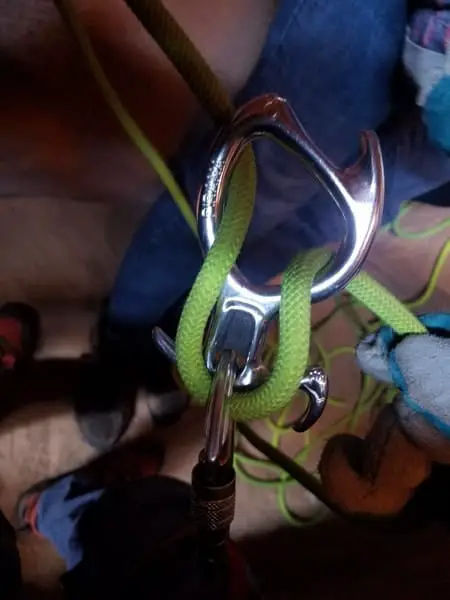
Petzl “Pirana”
Petzl came out with one of the first rappel devices specific to canyoneering. The Pirana works as a modified 8 ring, with additional ‘fins’ on the bottom and a ‘tooth’ on top for modifying friction.
The main problem that people have is that the friction levels are not enough for rappellers above about 180 lbs (80kg). The other problem I ran into with the Pirana is that the plastic fitting in the carabiner slot is too small for many standard carabiners, which is one thing I like about other devices that use a rubber o-ring.
The Pirana has 3 standard settings, as well as other unofficial setups. It works really well for lighter-weight people, especially when rappelling on really skinny ropes. It can be locked off fairly easily, which is a bonus as well. I find that it works really well when compared to non-canyoneering devices, but has been surpassed by recent innovations.
Note that, as of 2022, the latest version (2020) of the Pirana has been recalled. You can view the notice here . It doesn’t appear to affect the older version.
. It doesn’t appear to affect the older version.
View on Amazon: PETZL Pirana Descender
Rock Exotica “Totem”
The Totem is a hybrid of a plate-style device like an ATC and an 8 ring, and is designed to be versatile enough to use for everything. The problem is that it isn’t quite as user-friendly as some of the other devices. While it can do everything, even including ascending, it takes a lot of knowledge and practice to get right.
I see guides using these a lot, since they can rig multiple rappels at once. The other main issue is that it’s longer than any of the other devices listed. If you think this one isn’t complicated enough, check out their Phoenix CRT !
!
View on Amazon: OmniPro Gear Rock Exotica Totem Descender F10

8 Ring
Every gear company has their own 8 ring, and there are plenty of off-brands out there available from both reputable and non-reputable sources. I’ve written a lot about the 8 ring in a previous article, which you can read here .
.
I love the versatility and simplicity, and think that it’s a great backup device to bring in your bag on any canyon. That being said, you can have a lot more control (and safety) using a device with more friction settings.
There are several different variations of 8 rings out there, and I’ve tried out a handful of them. A Rescue 8, an 8 ring with ‘horns’ or ‘ears’ on the top, does make it possible to vary the friction a bit, and even makes tying off easier.
My dad bought CMI’s “El Diablo” rappel device a while ago. He likes the functionality, but I’ve heard that it is made from a softer aluminum than other devices, and wears out faster. My brother has Kong’s “Oka” rappel device. Its functionality is similar to the Pirana, but I’ve also heard of issues with durability after particularly brutal canyons.

Tubular Devices (ATC’s)
As with a traditional 8 ring, every company has its own version of Black Diamond’s ATC. They work great as a backup device for canyoneering, especially since they’re so small and lightweight, but have a lot of shortcomings as a primary device.
First and foremost, there’s no easy way to adjust the friction level. While you can rig an awkward double carabiner or leg loop carabiner, these things have to be done before you go over the edge.
ATC’s, because of their tight slots, do not allow moss and other gunk inherent in canyoneering to pass through with the rope. It could be hazardous in a class C canyon with significant waterflow to have your descender gum up in the wrong spot.
The only way to release the rope is to open the carabiner- which can easily lead to you dropping the device in the water at the bottom of a rappel. Many canyoneers use an ATC as a backup to their main device, which is a good option. In the event of an emergency it works well enough, but you don’t want to rely on it as a primary.
See also: How to Rappel With an ATC
Related Questions
What is the best belay device for rappelling? The advice for rappelling follows the advice for canyoneering- the best device allows for multiple friction levels and a way to stop and go hands-free. Several devices, including the On Rope Canyoneering Hoodoo SL and the Canyonwerks Critr 2 accomplish this task. The easiest rappel devices to use are a traditional 8 ring or a tubular device like an ATC.
What are the best backpacks for canyoneering? A lot of different companies, including Imlay, Rodcle, and On Rope Canyoneering sell a variety of different backpacks and bags designed for canyoneering. You can read more about canyoneering bags on our Recommended Gear Page .
.
How do you Ghost a Canyon? Ghosting a canyon is where you descend through the whole canyon without leaving any gear. This may include retrievable anchors, sand traps, or w’anchors. There are a variety of options for ghosting a canyon, which are detailed in my post: How to Rappel Without Leaving Gear .
.
What are Canyoneering Shoes? Canyoneering is extremely rigorous, and is very demanding on your gear. Canyoneering shoes need to be extremely durable, need to have excellent traction when wet or dry, and need to drain water freely. There are only a few different pairs of shoes designed specifically for canyoneering, but there are several great options in the family of Approach Shoes. I wrote all about the best shoes for canyoneering in this article: What are the Best Canyoneering Shoes?
See Also:
Is Canyoning Dangerous? Canyoneering Safety Tips

